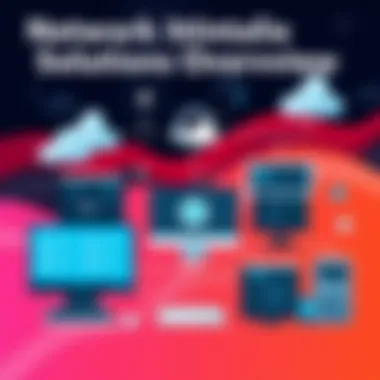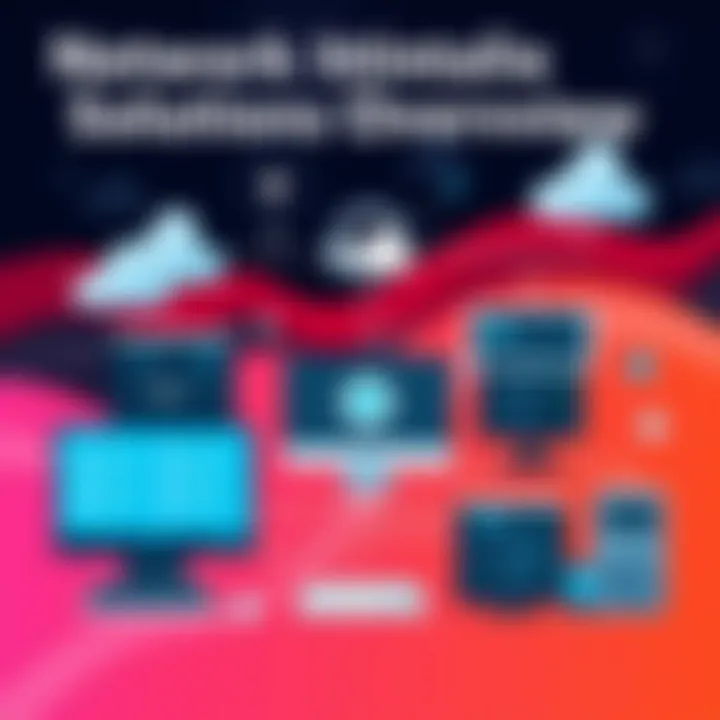Exploring Alternatives to ThousandEyes for Network Monitoring


Intro
In a world where digital infrastructures form the backbone of corporate operations, choosing the right network visibility and performance monitoring tool can feel like finding a needle in a haystack. ThousandEyes stands as a prominent player in this arena, but it is not the only option. As businesses increasingly depend on robust network performance for productivity and growth, identifying reliable alternatives becomes vital. This article embarks on a journey through the myriad options available, analyzing their features, strengths, and weaknesses.
With a focus on usability, pricing, and technology stacks, this exploration is geared toward IT professionals, business owners, and decision-makers seeking clarity amid a crowded marketplace. Whether you aim to enhance network visibility, address specific pain points, or find a cost-effective solution, understanding the competitive landscape will position you to make informed choices that align with your organizational goals.
Let's get into the meat of it and navigate through these alternatives together.
Key Features
Overview of Core Features
When evaluating alternatives to ThousandEyes, one must look beyond mere surface-level attributes. Core features differentiate offerings in the forecast of performance monitoring.
- Network Visibility: A standout feature across various platforms is the ability to provide real-time visibility into the network landscape. Tools like Datadog and SolarWinds offer comprehensive dashboards that visualize data flows and anomalies, something that businesses can't ignore.
- Monitoring Depth: Some tools excel in monitoring application performance, while others emphasize network health. For instance, AppDynamics focuses on application performance, granting insights into user experiences by tracking response times and transaction traces. It’s essential to align these monitoring capabilities with your operational requirements.
- User Alerts: Many platforms now leverage machine learning to enhance alert systems. This means that tools can devise smarter notification systems that minimize alert fatigue and focus on genuinely critical issues. New Relic offers such adaptive alert mechanisms, ensuring that teams react promptly to impactful events.
User Interface and Experience
Usability can often determine the success of a monitoring solution. A clunky, unintuitive interface can lead to missed insights and complicate daily operations.
- Navigational Design: A clean, straightforward navigation design can save hours of frustration. Tools like Pingdom boast a user-friendly interface that makes navigation a walk in the park. Efficiency matters, especially in high-stakes environments where every second counts.
- Customizability: The ability to customize dashboards and reports to fit individual or team needs can greatly enhance user experience. Zabbix enables deep customization, allowing data to be represented in formats that resonate with team members.
Understanding ThousandEyes: An Overview
In this digital age, network performance and visibility are paramount for businesses aiming to maintain a competitive edge. ThousandEyes stands out as a renowned solution in this sphere, offering a comprehensive look into network interactions and application performance. To make informed decisions regarding alternatives, it is vital to grasp what ThousandEyes entails—its essence, features, and the critical notion of network visibility. This context serves as a stepping stone into the competitive environment of network monitoring, where various players vie for attention and usability.
What is ThousandEyes?
ThousandEyes is a leading platform designed specifically for network visibility and performance monitoring. It captures the complex interactions occurring across various network paths, allowing organizations to pinpoint issues before they escalate into significant problems. By utilizing agents installed on endpoints, as well as synthetic tests, ThousandEyes provides insights into how services perform not just within a company's internal network, but also how they interface with external entities.
The platform provides extensive visibility into a multitude of network metrics—including latency, packet loss, and throughput—enabling IT teams to troubleshoot effectively. This capability is essential, especially in hybrid environments where applications leverage both cloud services and on-premises infrastructures. Without a doubt, understanding what ThousandEyes can do is crucial for businesses contemplating their monitoring choices.
Key Features of ThousandEyes
ThousandEyes boasts several key features that set it apart from traditional network monitoring tools:
- Comprehensive Network Insights: The platform’s ability to visualize network behavior in real-time is substantial. Users can observe both end-user experiences and network performance.
- Synthentic Monitoring: This feature simulates user interactions with applications, allowing IT teams to identify potential bottlenecks before they affect real users.
- BGP Alerts: By integrating Border Gateway Protocol metrics, ThousandEyes helps users track routing changes that might impact traffic flow.
- Cloud and Application Monitoring: It offers specialized monitoring for cloud services, ensuring that organizations can confirm performance and uptime across various platforms, including Amazon Web Services and Microsoft Azure.
- User-Friendly Dashboard: With an intuitive interface, even non-technical stakeholders can access key performance indicators and understand network health.
Each of these functionalities is engineered to not only aid in monitoring but also to enhance strategic decision-making within IT departments.
The Importance of Network Visibility
Network visibility is not just a buzzword; it is a vital asset for any organization striving to ensure optimal performance. The complexities of modern IT infrastructure—consisting of clouds, data centers, and myriad services—make it necessary to have a granular view of how data flows and where potential disruptions could arise. With ThousandEyes, businesses gain the upper hand in dissecting issues that cloud performance and greatly impact user experiences.
"In today’s interconnected world, lack of visibility into your network can cost you more than you think; it can lead to revenue loss and tarnished reputations."
Furthermore, improved network visibility enables proactive management, ensuring that problems can be identified and resolved before they disrupt operations. This foresight is invaluable as companies increasingly rely on digital channels for service delivery, notably during peak traffic times. Without a clear vision of network dynamics, sustaining reliability becomes a daunting task.
The considerations surrounding ThousandEyes are indeed pivotal for understanding the competitive landscape of its alternatives. By familiarizing yourself with its capabilities, you're better equipped to navigate the numerous options available in this dynamic market.
The Competitive Landscape
Navigating the network visibility space requires a keen understanding of the competitive landscape. Here, various companies vie for the attention of IT professionals and decision-makers, each presenting distinct solutions that address different aspects of network performance. Understanding who the competitors are and what they bring to the table is crucial, not just for making informed decisions, but for ensuring that businesses don’t end up pouring resources into solutions that don’t fit their unique needs.
Identifying Key Competitors
The first step in understanding the competitive landscape is to identify the key players. Some notable alternatives to ThousandEyes include New Relic, Datadog, Dynatrace, Splunk, and AppDynamics. Each of these platforms caters to slightly different audiences and addresses various network monitoring needs.
- New Relic focuses on application performance and is known for its robust reporting capabilities.
- Datadog excels in infrastructure monitoring and integrates seamlessly with major cloud providers.
- Dynatrace leverages artificial intelligence for automated monitoring, which can be a game-changer for companies that require real-time performance insights.
- Splunk is tailored more for big data analytics and log management, making it a unique competitor in this space.
- AppDynamics offers deep visibility into application performance and user experience, catering primarily to enterprises.
From this array, knowing which competitor aligns with specific organizational goals sets the stage for evaluating their strengths and weaknesses in depth.
Market Dynamics and Trends
In the ever-evolving tech ecosystem, staying attuned to market dynamics and trends is essential. The landscape of network monitoring is influenced by several factors:
- Cloud Adoption: As businesses increasingly migrate to cloud solutions, competitors that integrate cloud visibility alongside network monitoring are gaining ground.
- Increased Cybersecurity Concerns: With rising incidents of cyber threats, platforms emphasizing security alongside monitoring trends are becoming more appealing.
- AI and ML Integration: Companies looking for full-fledged solutions are turning to those using artificial intelligence and machine learning to enhance predictive capabilities, which allows for proactive network management.
- Remote Work Influence: The shift to remote work has changed the way network performance is evaluated. Solutions that can provide visibility into remote workers' experiences are growing in importance.
Understanding these dynamics not only helps in contrasting the features of ThousandEyes alternatives but also highlights what organizations should focus on when choosing a solution.
A Deep Dive into ThousandEyes Competitors


In a market where network performance monitoring is crucial for maintaining optimal user experiences, understanding the available alternatives to ThousandEyes is essential. A closer inspection not only highlights the strengths and weaknesses of various competitors but also equips businesses with the insights necessary to make informed decisions. The significance of this section lies in the fact that several contenders have emerged, each offering unique features tailored to different organizational needs. By exploring each competitor in depth, companies can align their specific requirements with the strengths of these tools, potentially leading to improved operational efficiency and customer satisfaction.
Competitor One: New Relic
Overview of New Relic
New Relic is renowned for its comprehensive application performance monitoring (APM) capabilities. Designed to track various app metrics, it offers real-time insights that help organizations swiftly diagnose and troubleshoot performance issues. One standout characteristic is its user-friendly dashboard, which presents data in an easily digestible format, making it appealing to many small and medium-sized businesses. Notably, New Relic provides a robust integration ecosystem, allowing users to connect with a variety of platforms and services seamlessly. It supports greater visibility across the entire technology stack, which is a major boon for organizations operating in a multi-tool environment.
Strengths and Weaknesses
The strengths of New Relic lie in its real-time data collection and user interface. Organizations benefit from quick insights, enabling faster decision-making. However, it may come with a steep learning curve for teams not well-versed in data analysis. Additionally, some users point out that while the platform is powerful, its advanced features can sometimes be overwhelming for new users. In this competitive landscape, it’s a solid choice for those needing detailed app monitoring; nonetheless, its complexity may deter simpler use cases.
Pricing Structure
New Relic employs a consumption-based pricing model, which means organizations pay for what they use. This can be advantageous for companies with variable workloads, but it can also lead to unpredictable costs. The flexibility of this pricing model is beneficial for startups and small companies; however, larger organizations may find it less economical in the long run. Thus, while the pricing structure offers adaptability, companies need to keep an eye on how it scales with their growth.
Competitor Two: Datadog
Overview of Datadog
Datadog stands out as a multi-faceted monitoring platform, offering not just APM but also infrastructure monitoring and log management. This comprehensive suite makes it a go-to choice for organizations looking to unify their monitoring needs under one roof. One key characteristic is its ability to provide visibility into cloud-scale applications, thanks to integrations with a myriad of cloud service providers. This adaptability is fundamental, considering the growing trend towards cloud-native architectures.
Strengths and Weaknesses
A strong point in Datadog's favor is its integration capability, which allows for easy connection with numerous tech stacks and third-party services. It facilitates a centralized view of application and infrastructure metrics, which enhances troubleshooting efficiency. However, the breadth of features can lead to information overload for users less familiar with data analysis. Moreover, the cost may become a concern for smaller businesses if not monitored carefully, as Datadog uses a tiered pricing model that could escalate expenses based on the number of hosts monitored.
Pricing Structure
Datadog’s pricing structure is tiered based on the specific features and the number of hosts. This could be suitable for growing companies needing scalability, yet it might also deter companies with limited budgets. Understanding this pricing mechanism is vital when aligning it with specific monitoring needs, as it can significantly affect the overall cost of ownership.
Competitor Three: Dynatrace
Overview of Dynatrace
Dynatrace takes a proactive approach with its AI-driven monitoring solutions. This platform utilizes artificial intelligence for performance insights, enabling predictive analytics that help organizations identify potential issues before they escalate. A key feature is its automatic instrumentation, which reduces the manual setup required by users and allows for faster deployment times.
Strengths and Weaknesses
Dynatrace’s strengths lie in its automation capabilities, allowing teams to monitor more applications with less manual oversight. Additionally, the AI features significantly enhance anomaly detection, which is crucial in a landscape where issues can arise unexpectedly. On the downside, the implementation process can be daunting for some organizations, especially those lacking in-house technical expertise. The overall complexity of its offerings may deter businesses that are seeking straightforward monitoring solutions.
Pricing Structure
Dynatrace’s pricing is primarily based on its licensing model, focusing on specific features and usage metrics. This structure can favorably accommodate organizations of different sizes, but it often leads to higher expenses for comprehensive monitoring needs. Understanding how pricing relates to the specific tools needed can help decipher whether Dynatrace is a cost-effective solution for any given business.
Competitor Four: Splunk
Overview of Splunk
Splunk is widely recognized as a capable observability and analytics platform, best suited for large organizations with extensive data monitoring needs. It excels in log management, turning machine-generated data into actionable insights. One unique feature is its ability to index and search vast datasets, which makes it beneficial for companies with complex IT infrastructures. This data-driven approach allows for more informed decision-making across an organization.
Strengths and Weaknesses
The biggest strength of Splunk lies in its analytical prowess, as it is tailored for deep data analysis and reporting. This can provide valuable insights into IT operations. However, one of its weaknesses is the associated costs. Splunk's licensing model can become quite expensive for smaller companies or those who do not require comprehensive logging and analysis functionalities. Users must weigh the depth of features against their operational budget when considering Splunk.
Pricing Structure
Splunk's pricing model is generally based on the amount of data ingested per day. This pay-per-use structure can be advantageous for companies that can scale their data usage precisely; however, it may also become a financial burden for organizations with high data volume. Knowing how this model works is critical in forecasting overall expenditure.
Competitor Five: AppDynamics
Overview of AppDynamics
AppDynamics prioritizes business-centric monitoring, focusing on how applications impact user experiences and revenue. This makes it a compelling option for organizations aiming to track application metrics in a way that ties directly to business outcomes. One notable feature is its end-user monitoring capabilities, which provide insights into the experiences of users interacting with applications.
Strengths and Weaknesses
A key strength of AppDynamics is this alignment of application performance with business metrics, allowing for focused insights. This approach helps organizations make more strategic decisions. Conversely, its more business-oriented focus can occasionally obscure technical details critical for IT teams. The dual nature of its monitoring can be beneficial and burdensome, depending on the needs of the organization.
Pricing Structure
The pricing for AppDynamics is based on the number of application connections and the various features activated. While this can provide flexibility, companies should consider whether they need the extensive coverage that could increase costs. Understanding how the pricing correlates with features is essential for effectively budgeting the monitoring solutions.
In summary, each alternative to ThousandEyes brings a unique approach to network monitoring with distinct strengths and weaknesses. By considering these core aspects, organizations can better gauge which platform best aligns with their specific needs.


Comparative Analysis of Features
In a world where digital operations rely heavily on the seamless performance of network monitoring, understanding the comparative analysis of features among ThousandEyes alternatives becomes paramount. Companies face unique challenges when selecting the right tool for their needs. Demonstrating insight into various feature sets not only aids in pinpointing the right product but also highlights distinctions crucial to sustaining network efficiency.
When embarking on a comparative analysis, one should weigh factors like real-time visibility, alerting mechanisms, and integration capabilities. These elements can dramatically influence how your organization navigates its networking needs. Critical analyses empower businesses to choose the right platform that complements their existing technological stack, thereby optimizing ROI in the long run.
Features can make or break a network monitoring solution. Thoroughly examining these attributes will provide clarity. As such, key aspects such as usability, custom reporting, and data visualization will be evaluated, ensuring that decision-makers are well-equipped for their choices. A simplified decision-making process can arise when critical features are organized into a comparison framework.
"Understanding your options is the first step towards making informed decisions in tech landscape."
This element bridges subjective perceptions and objective metrics, ensuring that organizations can transcend guesswork when selecting a solution that fits the bill.
Feature Comparison Matrix
Creating a feature comparison matrix is more than just collating data points. It’s about stripping away the noise and allowing a clear view of what each alternative brings to the table. Below is an illustration of how such a matrix may appear:
| Feature | New Relic | Datadog | Dynatrace | Splunk | AppDynamics | | Real-time Monitoring | Yes | Yes | Yes | Yes | Yes | | Custom Dashboards | Yes | Yes | Yes | Yes | Yes | | Anomaly Detection | Moderate | High | High | Moderate| High | | Integrations Available | Extensive | Extensive| Moderate | High | High | | Pricing Model | Subscription| Subscription| Usage-based | Subscription| Usage-based |
This example matrix provides immediate clarity on which tools may excel in certain areas. It can save time and effort, cutting straight to what matters; knowledge is power.
Using the matrix effectively
When using the matrix, think about your organization’s specific needs: What kind of network visibility do you require? How critical is real-time monitoring for your operations? Such questions help narrow down choices according to the selected features.
Performance Metrics to Consider
When deciding on software for network monitoring, one cannot overlook essential performance metrics that will dictate how effective a solution is in real-world applications. Metrics provide valuable insight into responsiveness, uptime, and end-user experience, which are critical undercurrents of network success.
A few notable performance metrics to consider include:
- Latency: How quickly data travels from point A to point B. Lower latency often translates to a better user experience.
- Throughput: The amount of data processed in a given time period. Higher throughput means better capacity to manage larger loads.
- Packet Loss: A measure of data packets that do not reach their destination. Minimizing packet loss is key to ensuring quality in communications.
- Error Rates: Tracking the frequency of errors can help identify issues that affect service quality.
Focusing on these metrics aligns directly with achieving clarity in the competitive environment.
Each of these indicators sheds light on crucial aspects of how a network operates in real time, allowing businesses to make decisions rooted in data rather than abstract feelings.
Evaluating Pricing Models
When it comes to investing in network monitoring solutions, understanding the pricing models of alternatives to ThousandEyes is essential. In the highly competitive tech industry, selecting a platform is not merely about the initial purchase price. It’s a multifaceted decision that requires careful consideration of how pricing aligns with your business objectives and operational needs. When businesses opt for network monitoring tools, the right pricing structure can mean the difference between effective cost management and financial drain.
A well-structured pricing model allows for transparency, helping companies align costs with the value gained from the service. This becomes crucial as organizations grow, necessitating scalable solutions without breaking the bank. Furthermore, a real solid grasp of the pricing mechanisms in play can foster informed negotiations and even lead to discovering hidden costs often overlooked in the initial stages of decision-making.
Understanding Pricing Structures
Delving deeper into pricing structures, it's important to note that these can vary significantly across platforms. At their core, they typically fall into a few categories:
- Subscription-Based Models: Many services charge a recurring fee, often monthly or annually. This model provides predictability in budgeting but can lead to high lifetime costs if the tool isn’t utilized effectively.
- Usage-Based Pricing: Some alternatives charge based on usage levels—meaning the more you use the service, the more you pay. This can be beneficial for businesses with fluctuating demand, but it can also lead to unexpected expenses if traffic spikes occur.
- Tiered Pricing: This structure offers different service levels at varying price points. Organizations can choose a package that aligns with their needs, but careful analysis is required to ensure the selected tier doesn’t lead to overlooked features.
"Knowing how you’re charged is just as important as knowing what you’re getting. Fail to pay attention to the fine print, and you might end up sitting on a costly misstep."
By mapping out these pricing structures, companies can better align their needs with what is offered. Thus, the initial step should include a thorough review of the pricing tiers, exploring what's included in each level. Make no mistake—this is where a deep understanding of the product features comes in handy as well, ensuring that the financial commitment matches the operational benefits.
Cost-Benefit Analysis
The final piece of the pricing puzzle is conducting a cost-benefit analysis. At a glance, it might seem straightforward; however, it requires a meticulous approach. Here's how you can break it down effectively:
- Identify Needs: Start by categorizing your business requirements. Are you primarily seeking performance monitoring, or is it network visibility that’s crucial? This clarity aids in matching costs with benefits.
- Align Features with Costs: Look at the features offered against their associated costs. Does the package you’re considering provide you with tools and support that justify its price tag?
- Project Future Needs: Consider the scalability of the solution—will it grow with you? A platform that meets your needs today may not suffice tomorrow.
- Budget Considerations: Balancing short-term pricing against long-term value is vital. While a lower initial cost may seem appealing, consider whether it’ll incur higher costs down the line due to lack of features or inadequate support.
Engaging in this analysis not only aids in understanding whether you're getting your money's worth but also sets the groundwork for make-or-break negotiations with vendors. The key is to be proactive. Don't hesitate to consult existing users, explore forums like Reddit for real-world insights, and scrutinize user reviews.
Keeping all these elements in mind while navigating the pricing models of ThousandEyes alternatives can empower businesses to make astute decisions that won’t just save dollars but will also funnel into broader organizational success.
User Experience and Usability
User experience and usability are cornerstones in the realm of network monitoring tools. In a fast-paced technological world, how easily a user can navigate a platform often dictates their overall satisfaction and effectiveness. As businesses lean more heavily on data analytics and performance metrics, intuitive designs and user-friendly interfaces are crucial.
When considering alternatives to ThousandEyes, organizations can’t afford to overlook the usability of these platforms. A well-designed interface can mean the difference between harnessing valuable insights and getting lost in a maze of complex dashboards and reports. Users need to access information quickly and efficiently, especially when time-sensitive decisions have to be made. Thus, the significance of a smooth user experience is paramount.
Evaluating User Interfaces
A user interface (UI) isn’t just about aesthetics; it’s about function, clarity, and ease of access. When evaluating the UIs of ThousandEyes alternatives, several aspects deserve attention:


- Intuitive Navigation: A logical flow in navigating the platform is essential. Users should be able to locate features without a convoluted search.
- Customization Options: The ability to tailor dashboards and reports to individual needs makes a tool more valuable, as not every business operates on the same parameters.
- Visual Appeal: While form should not overshadow function, an attractive and well-organized interface can enhance user engagement.
- Responsiveness: In the age of mobile and cloud-based tools, ensuring that the interface is equally effective on different devices is crucial.
Ultimately, enhancing user experience means maximizing productivity. A platform that anticipates the needs and workflows of its users creates a smoother operational environment.
Customer Support Services
The technical world is often fraught with challenges, and the quality of customer support can make or break a user’s journey with a network monitoring tool. With any alternatives to ThousandEyes, robust customer support becomes a non-negotiable aspect of the overall experience. Here are factors to consider when assessing customer support services:
- Availability: Support services should ideally be accessible 24/7, especially for businesses operating across multiple time zones.
- Knowledgeability: Support staff must not only be courteous but also deeply knowledgeable about the platform. Even minor issues can escalate if the support is ineffective.
- Multiple Channels: Offering different ways to get help—be it through chat, phone, email, or forums—can cater to various preferences and increase user satisfaction.
- Response Time: Quick response to inquiries and issues is essential. Users should not feel like they are left hanging when they encounter problems.
The effectiveness of a tool isn't solely dependent on its features—it's also about the relationship between the provider and the user. Strong customer support embodies a commitment to user success, enabling organizations to maximize their investment in these technologies.
An efficient customer support service can transform user experience dramatically, ensuring that tools function optimally in real-world scenarios.
Bringing together these elements of user experience and customer support helps users leverage the article's insights on ThousandEyes alternatives, allowing them to choose solutions that not only fit their technical requirements but also support their teams effectively.
Real-World Case Studies
Real-world case studies bring a practical perspective to the theoretical advantages of network monitoring solutions like ThousandEyes and its alternatives. In the tech world, theoretical claims about feature sets and performance metrics often fade into the background when faced with the gritty realities of implementation. People want to know what happens after the software is deployed—not just how it looks on paper. This section captures that essence, highlighting key examples that clarify the footprint these monitoring tools leave in the actual realm of business operations.
Exploring successful implementations showcases how organizations leverage these tools to address their unique challenges. These stories serve as inspirational beacons for decision-makers seeking to understand the tangible benefits of adopting such systems.
On the flip side, this journey is not without bumps on the road. Challenges faced by users give voice to the hurdles encountered, shedding light on possible issues and limitations, thus providing a balanced view for potential adopters. Understanding these difficulties equips IT professionals and business owners to navigate obstacles more effectively.
Successful Implementations
For companies choosing between the various alternatives to ThousandEyes, seeing how others have succeeded can guide decisions. For instance, a major financial services firm implemented Datadog to enhance their real-time visibility across a highly complex multi-cloud environment. They landed on Datadog primarily due to its robust integration capabilities, which simplified the overall monitoring process and provided actionable insights quickly—tangible outcomes that weren't just talked about in marketing materials.
Another noteworthy example comes from a tech startup utilizing New Relic for application performance monitoring. Within a few months, they reported a stunning 30% reduction in downtime, largely because New Relic's insights allowed them to proactively address potential issues before they escalated. Such metrics never lie and demonstrate how effective implementation can directly correlate with business performance.
Among larger enterprises, a healthcare provider made waves by integrating AppDynamics into their network strategy. This resulted in streamlined incident responses and a significant uptick in customer satisfaction ratings. They pointed to features like end-to-end transaction monitoring as essential in maintaining compliance with stringent health regulations and ensuring patient data integrity.
Understanding these successful implementations helps demystify the selection process for businesses wrestling with their network visibility needs. The crux here is not just the tool itself, but how it empowers teams to achieve better results, turning potential bottlenecks into smooth sailing.
Challenges Faced by Users
Despite remarkable successes, it's crucial to acknowledge the not-so-smooth experiences some users have encountered. One banking institution faced challenges with the onboarding process of Dynatrace, citing steep learning curves and integration complexities. They discovered that while the monitoring capabilities were robust, the initial setup was anything but user-friendly, resulting in several weeks of delays before they could start leveraging the platform effectively.
Similarly, a large retail chain deploying Splunk grappled with the overwhelming amount of data that the solution could generate. Their initial excitement quickly turned into frustration as they found it difficult to sift through vast volumes of information to find actionable insights. The learning curve associated with configuring alerts to minimize noise and maximize value became a significant source of recurring issues.
These challenges highlight important considerations for any organization contemplating an investment in network monitoring tools. They underscore the need for comprehensive user training and support post-deployment. A user-friendly interface, ease of integration, and ongoing support can make a world of difference, particularly in organizations with less technical proficiency.
While the right tool can drive results, the implementation experience can also make or break your network monitoring journey.
In summary, real-world case studies not only inspire with success stories but also prepare users for potential hurdles, making them a critical component of understanding the competitive landscape of ThousandEyes alternatives. By examining both ends of the spectrum, businesses can arm themselves with knowledge, mitigating risks and optimizing their monitoring strategies.
Future Trends in Network Monitoring
As organizations increasingly depend on seamless network performance, understanding the trends shaping network monitoring is crucial for maintaining a competitive edge. This section delves into emerging technologies and market predictions, providing insights that can help businesses navigate the future.
Emerging Technologies
The world of network monitoring is evolving swiftly, driven by advancements in several key technologies. Here are a few notable players to keep an eye on:
- Artificial Intelligence (AI): AI is making its mark in proactive network monitoring. Intelligent algorithms can analyze vast datasets in real time, spotting anomalies that a human might miss. This helps in preemptively addressing issues before they escalate, enhancing network reliability.
- Machine Learning (ML): While closely knit with AI, ML specifically focuses on patterns. By using ML algorithms, businesses can predict traffic spikes or detect unusual usage patterns, allowing for swift adjustments to maintain optimal performance.
- Software-Defined Networking (SDN): This tech separates the control plane from the data plane, streamlining the management of network resources. It allows for more agile responses to changing network conditions, which is essential for modern enterprises.
- Internet of Things (IoT): With the proliferation of IoT devices, network monitoring strategies must adapt. Real-time visibility into IoT traffic patterns helps organizations manage bandwidth, ensuring critical applications remain unaffected by the sheer volume of data from smart devices.
"In the rapidly changing landscape of IT, staying aware of emerging technologies is not just advantageous; it's essential for survival."
Predictions for the Market
Now, let’s look into how these emerging techs will shape the network monitoring market in the near future:
- Increased Automation: Automation will continue to grow, allowing for faster incident response and less manual intervention. Predictive analytics will further refine this, moving businesses towards a more autonomous network management model.
- Focus on Security: As cyber threats increase, network monitoring will place greater emphasis on security. Tools that integrate network performance with security measures will be in high demand, ensuring organizations are not only aware of their network's health but also its vulnerabilities.
- Cloud-Based Solutions: The shift towards cloud infrastructure will lead to more robust cloud-based monitoring tools. Software-as-a-Service models will dominate, providing scalable and flexible solutions tailored to organizational needs.
- User-Centric Design: As user experience becomes paramount, monitoring tools will adopt more intuitive interfaces. A user-friendly approach means IT professionals can spend less time learning how to use the tools and more time acting on insights.
Understanding these future trends in network monitoring can use the information to make strategic choices, ensuring their organizations don't just keep pace with change but also lead it.
Final Recommendations
In the complex arena of network monitoring solutions, the journey of choosing the right alternative to ThousandEyes involves several layers of decision-making. Final recommendations play a critical role as they distill the abundant information presented throughout this article into actionable insights. This section aims to equip businesses with essential guidelines and thought processes necessary to make informed choices.
Choices in technology can significantly impact your operations, making it essential to weigh the unique capabilities of each platform alongside your specific needs. Below are key elements to consider when reviewing the alternatives:
- Alignment with Business Goals: Look for solutions that not only address current technical needs but also align with your broader business objectives. Consider how each platform can enhance your organization's performance and provide insights that drive strategic decision-making.
- Scalability and Flexibility: As your business grows, so do your monitoring requirements. Opt for solutions that offer scalability, allowing you to add functionalities as needed. A flexible approach can save costs and stretch the value of your investment over time.
- Integration and Compatibility: The ability of the network monitoring tool to integrate with existing systems is non-negotiable. Investigate how well each alternative works within your current technology stack. This will simplify workflows and enhance overall efficiency.
- User Experience: The usability of any software solution cannot be understated. A platform that’s user-friendly can minimize training times and help your team get up to speed quickly. Consider platforms that offer intuitive interfaces and comprehensive support resources.
- Vendor Reliability: Do thorough research on the competitors, checking reviews and testimonials. A reputable vendor is more likely to offer reliable support and regular updates, which are vital for a stable network environment.
These considerations should guide your evaluation process and help you delineate which features matter most to your organization. Ultimately, you still need to weigh the trade-offs and benefits that each solution brings to the table.
"In choosing a network monitoring solution, the importance of aligning technology with business strategies cannot be understated. Your chosen tool should be not just a functional asset, but a strategic partner in your growth journey."
By synthesizing the information discussed throughout this article, you can form a clear picture of which ThousandEyes alternatives best match your requirements. Keeping these recommendations in mind, you will be better positioned to make a thoughtful decision that will enhance your organization’s network monitoring capabilities.







